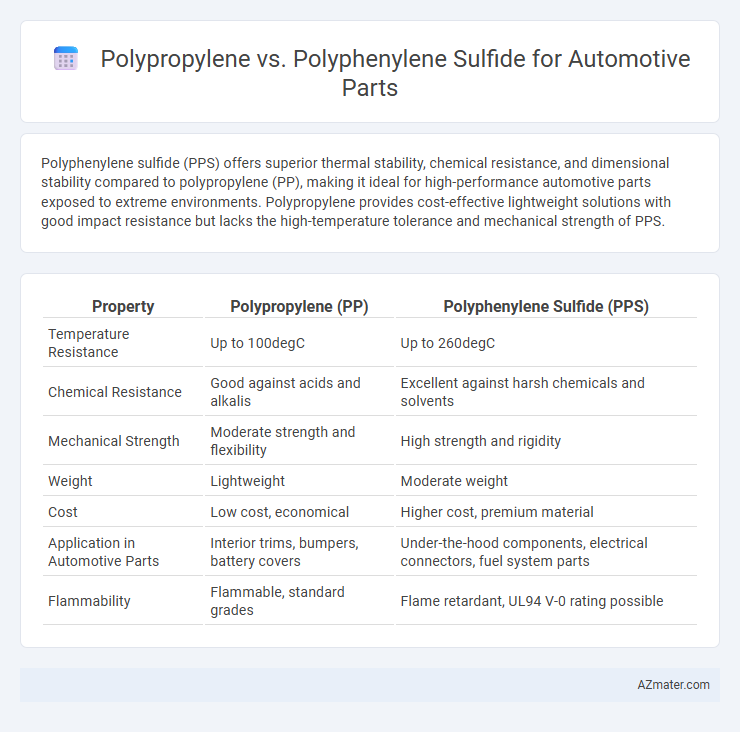Polyphenylene sulfide (PPS) offers superior thermal stability, chemical resistance, and dimensional stability compared to polypropylene (PP), making it ideal for high-performance automotive parts exposed to extreme environments. Polypropylene provides cost-effective lightweight solutions with good impact resistance but lacks the high-temperature tolerance and mechanical strength of PPS.
Table of Comparison
| Property | Polypropylene (PP) | Polyphenylene Sulfide (PPS) |
|---|---|---|
| Temperature Resistance | Up to 100degC | Up to 260degC |
| Chemical Resistance | Good against acids and alkalis | Excellent against harsh chemicals and solvents |
| Mechanical Strength | Moderate strength and flexibility | High strength and rigidity |
| Weight | Lightweight | Moderate weight |
| Cost | Low cost, economical | Higher cost, premium material |
| Application in Automotive Parts | Interior trims, bumpers, battery covers | Under-the-hood components, electrical connectors, fuel system parts |
| Flammability | Flammable, standard grades | Flame retardant, UL94 V-0 rating possible |
Introduction: Importance of Material Selection in Automotive Parts
Material selection plays a critical role in automotive parts manufacturing, directly impacting durability, performance, and cost-efficiency. Polypropylene offers excellent chemical resistance, lightweight properties, and cost-effectiveness ideal for interior components and under-the-hood applications. Polyphenylene sulfide provides superior thermal stability, mechanical strength, and dimensional stability, making it suitable for high-performance engine parts and electrical components.
Overview of Polypropylene and Polyphenylene Sulfide
Polypropylene (PP) is a versatile thermoplastic known for its lightweight, chemical resistance, and cost-effectiveness, making it widely used in automotive interior components such as dashboards and trim panels. Polyphenylene sulfide (PPS) offers superior thermal stability, chemical resistance, and mechanical strength, ideal for under-the-hood applications requiring high heat tolerance. Both materials play critical roles in automotive manufacturing, with PP favored for general-purpose parts and PPS selected for demanding environments exposed to high temperatures and harsh chemicals.
Mechanical Properties Comparison
Polypropylene (PP) offers moderate tensile strength and excellent impact resistance, making it suitable for automotive parts requiring flexibility and lightweight characteristics. Polyphenylene sulfide (PPS) outperforms PP with superior thermal stability, higher tensile strength, and exceptional dimensional stability, ideal for under-the-hood components exposed to high temperatures. The enhanced mechanical properties of PPS, including better chemical resistance and rigidity, contribute to longer service life and improved performance in demanding automotive applications.
Thermal Stability and Heat Resistance
Polyphenylene sulfide (PPS) exhibits superior thermal stability and heat resistance compared to polypropylene (PP), maintaining mechanical integrity at continuous use temperatures up to 260degC, while polypropylene typically withstands only up to 100-120degC. PPS's high melting point and excellent dimensional stability under thermal stress make it ideal for automotive parts exposed to engine heat and harsh under-the-hood environments. Polypropylene, although cost-effective and lightweight, is more prone to thermal deformation and degradation at elevated temperatures, limiting its use in high-heat automotive applications.
Chemical Resistance in Automotive Environments
Polyphenylene sulfide (PPS) exhibits superior chemical resistance compared to polypropylene (PP) in demanding automotive environments, withstanding exposure to acids, fuels, and solvents without degradation. PPS maintains mechanical integrity and dimensional stability under prolonged contact with automotive fluids, making it ideal for engine components and fuel system parts. Polypropylene, while resistant to many chemicals, is prone to swelling and cracking in harsh solvents and high-temperature conditions typical in automotive under-the-hood applications.
Weight and Design Flexibility
Polypropylene offers a lightweight solution for automotive parts, significantly reducing vehicle weight and improving fuel efficiency. Polyphenylene sulfide (PPS) provides superior design flexibility due to its high thermal stability and chemical resistance, enabling complex geometries and precision molding. PPS parts generally weigh more than polypropylene but excel in durability and performance under demanding automotive conditions.
Cost Efficiency and Economic Considerations
Polypropylene offers lower material and processing costs compared to polyphenylene sulfide, making it a cost-efficient choice for automotive parts requiring flexibility and chemical resistance. Polyphenylene sulfide, while more expensive, provides superior thermal stability and mechanical strength, justifying its higher price in high-performance or under-hood applications. Evaluating total lifecycle cost, including durability and maintenance, is crucial for selecting the optimal polymer based on specific automotive part requirements.
Processing and Manufacturing Differences
Polypropylene (PP) offers ease of processing with low melt temperature and excellent flow properties suited for injection molding of automotive parts, resulting in shorter cycle times and lower energy consumption. In contrast, Polyphenylene Sulfide (PPS) requires higher processing temperatures, typically above 300degC, and specialized equipment due to its high thermal and chemical resistance, making it ideal for under-the-hood components demanding high-performance materials. Processing PPS involves more complex manufacturing steps such as extrusion and compression molding, whereas PP's versatility allows for broader manufacturing methods including blow molding and thermoforming.
Applications in Automotive Components
Polypropylene (PP) is widely used in automotive components such as bumpers, interior trim, and battery cases due to its excellent chemical resistance, low density, and cost-effectiveness. Polyphenylene sulfide (PPS) is preferred for under-the-hood applications including connectors, pump components, and housings because of its superior thermal stability, high mechanical strength, and resistance to hydrocarbons. Selecting between PP and PPS depends on the specific requirements for temperature resistance, mechanical durability, and exposure to chemicals in automotive environments.
Conclusion: Choosing the Best Material for Automotive Parts
Polyphenylene sulfide (PPS) offers superior thermal stability, chemical resistance, and dimensional stability compared to polypropylene (PP), making it ideal for automotive parts exposed to high temperatures and harsh environments. Polypropylene remains a cost-effective choice with good impact resistance and ease of processing for less demanding applications. Selecting between PPS and PP ultimately depends on specific performance requirements, balancing cost-efficiency with durability and operating conditions in automotive component design.

Infographic: Polypropylene vs Polyphenylene sulfide for Automotive part
 azmater.com
azmater.com